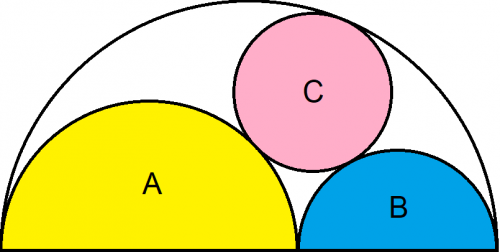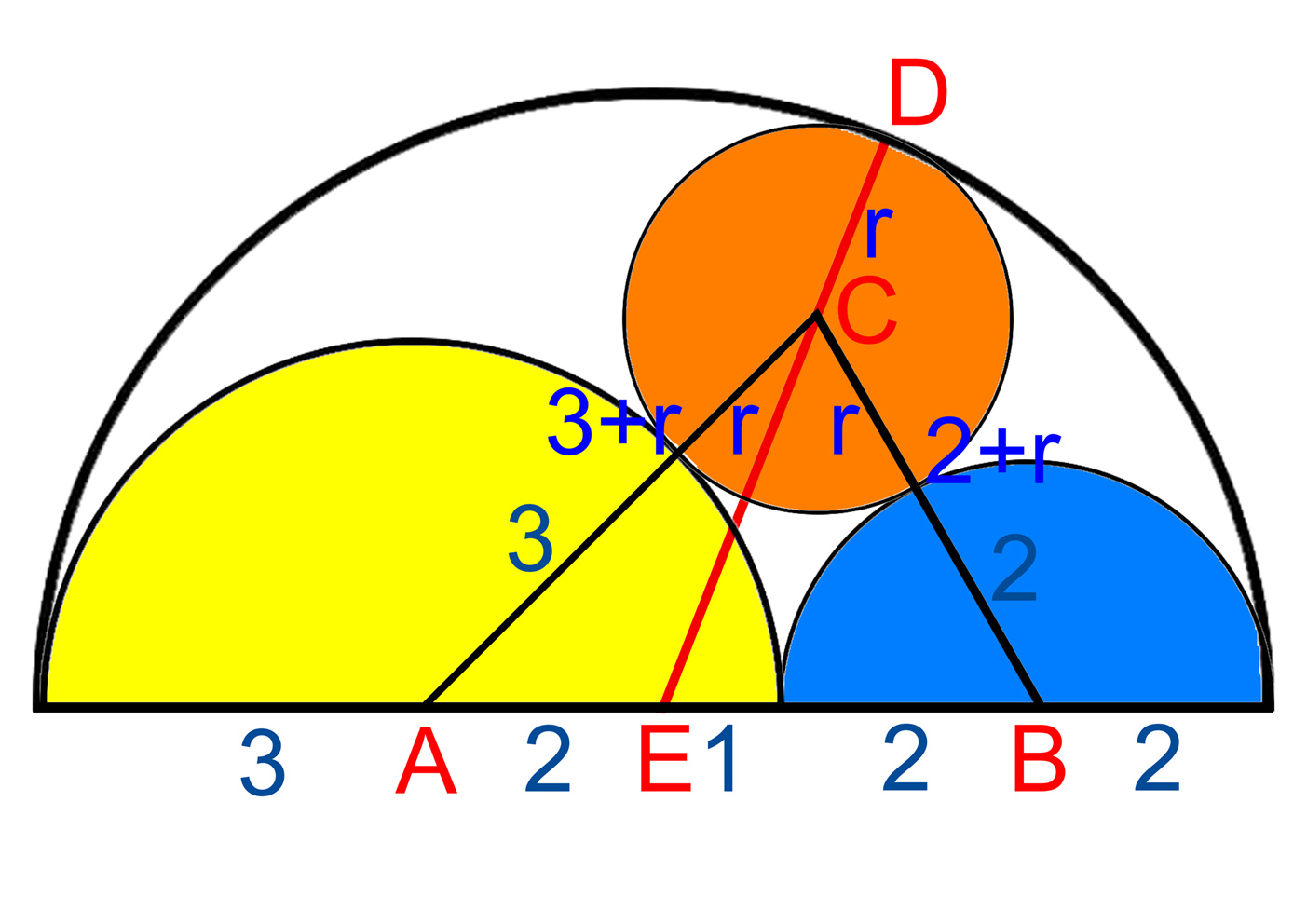
A and B are semicircles in in larger semicircle enclosing A, B, and circle C. Circle C is tangent to A, B, and the larger semicircle.
The base of A has length 6
The base of B has length 4
What is the radius of C?
Usual rules:
1. Please don't just plop a URL to a solution elsewhere until a winner here has been declared.
2. All those who have won a beer previously are asked to not post answers or solutions for 24 after this posting.
3. Beer to the first satisfactory answer and solution, subject to rule 2.
4. Please put answers and solutions in spoiler tags.
Wizard, I've seen this before. Without pre-knowledge of Descartes' work, or google, I can't see anyone solving this on their own.
Here's my solution:
Now since Tac is tangent to both A and C, we have a straight line passing from Ca through Tac to Cc with a length of 3+r. Similarly, since Tbc is tangent to both B and C, we have another straight line passing from Cb through Tbc to Cc with a length of 2+r. We also have a straight line from Ca to Cb with a length of 2+3=5.
These three lines from a right triangle with legs 2+r and 3+r and hypotenuse 5. From the Pythagorean Formula we get:
(2+r)^2 + (3+r)^2 = 5^2
r^2 +4r + 4 + r^2 + 6r + 9 =25
2r^2 + 10r - 12 = 0
r^2 + 5r - 6 = 0
So r = 1 is the only feasible solution.
Fun problem!
Dog Hand
I interpreted his "from" as a typo for "form." If I interpreted that correctly, how is it established that these lines form a right triangle? How do we know that the Ca-Cc line is perpendicular to the Cb-Cc line?
Edit: Ooops! Someone else asked basically the same thing while I was typing.
Quote: Wizard
A and B are semicircles in in larger semicircle enclosing A, B, and circle C. Circle C is tangent to A, B, and the larger semicircle.
The base of A has length 6
The base of B has length 4
What is the radius of C?
Usual rules:
1. Please don't just plop a URL to a solution elsewhere until a winner here has been declared.
2. All those who have won a beer previously are asked to not post answers or solutions for 24 after this posting.
3. Beer to the first satisfactory answer and solution, subject to rule 2.
4. Please put answers and solutions in spoiler tags.
I think can be solved as per attached image :-
https://ibb.co/D1T8vH1
Form 5 equations to solve for 5 unknown p, q, s, m and r ( radius of circle C ). L is center of larger semicircle.
Law of sines :-
1) LC/sin(p) = AL/sin(m)
2) LC/sin(q) = BL/sin(s)
3) AC/sin(q) = BC/sin(p)
4) AC/sin(q+s) = AL/sin(m)
5) p+q+m++s = 180
Quote: OnceDear
Wizard, I've seen this before. Without pre-knowledge of Descartes' work, or google, I can't see anyone solving this on their own.
I'm having fun (perhaps) trying to find an angle of attack without looking up the hint you gave in an earlier spoiler.Quote: Wizard
Yes, this one is rather difficult and I admit I had to cheat myself. I'll give a hint if nobody can solve it without one.
Quote: DogHandWiz,
Here's my solution:Let's call the centers of the lettered circles Ca, Cb, and Cc, and their intersection points Tac and Tbc. Let r be the unknown radius of C, while the radii of A and B are 3 and 2, respectively.
Now since Tac is tangent to both A and C, we have a straight line passing from Ca through Tac to Cc with a length of 3+r. Similarly, since Tbc is tangent to both B and C, we have another straight line passing from Cb through Tbc to Cc with a length of 2+r. We also have a straight line from Ca to Cb with a length of 2+3=5.
These three lines from a right triangle with legs 2+r and 3+r and hypotenuse 5. From the Pythagorean Formula we get:
(2+r)^2 + (3+r)^2 = 5^2
r^2 +4r + 4 + r^2 + 6r + 9 =25
2r^2 + 10r - 12 = 0
r^2 + 5r - 6 = 0
So r = 1 is the only feasible solution.
Fun problem!
Dog Hand
Quote: ssho88Form 5 equations to solve for 5 unknown p, q, s, m and r ( radius of circle C ). L is center of larger semicircle.
Law of sines :-
1) LC/sin(p) = AL/sin(m)
2) LC/sin(q) = BL/sin(s)
3) AC/sin(q) = BC/sin(p)
4) AC/sin(q+s) = AL/sin(m)
5) p+q+m++s = 180
I would have preferred you put that in spoiler tags. However, while those may be good hints, I don't see a correct answer in there.
Quote: OnceDearI'll throw you a bone.... It boils down to solving a quadratic and does not need the use of trig functions.
It's too early to give hints. After the 24-hour waiting period, if none of the math geniuses on the forum solve it, I'll offer a hint.
Quote: CharliePatrickI didn't need a quadratic so here goes.
Quote: WizardCharlie, congratulations, your answer is right and a well done solution.
However, it is in violation of the 24-hour rule. I have copied and pasted your post to you and will re-post it 24 hours from the OP, or you can do it.
If no previous winners get the answer within the 24 hour window, I will award you the beer.
Well done Charlie, I owe you another beer.
The way I did it does not require the use of Heron's formula, but the following formula...
a^2 = b^2 + c^2 - 2ab*cos(x),
where x is the angle opposite side a.
Quote: CharliePatrickI didn't need a quadratic so here goes.
Construct a line (DE), since the angle at D is 90deg E is at the centre of the large circle.
So AE=2, EB=3 etc. as shown.
Consider area of triangles AEC and EBC (i) Using Height and Width /2, then (ii) using Heron's formula.
Area AEC = AE * height /2 = 2 h / 2.
Area EBC = EB * height / 2 = 3 h / 2.
So ratio of areas is 2 : 3.
Area AEC = SQRT of 5 (5-2) 5-(3+r) 5-(5-r) = SQRT of 5 3 2-r r = SQRT of 5r 2 3-r = SQRT of 5r (6-2r).
Area EBC = SQRT of 5 (5-3) 5-(5-r) 5-(2-r) = SQRT of 5r (6-2r).
So SQRT ( (6-3r) / (6-2r) ) = 2/3.
Squaring (6-3r)/(6-2r) = 4/9 or 52-47r = 24-8r or 30-19r = 0
... or r=30/19.
I thought should be a^2 = b^2 + c^2 - 2bc*cos(x) ?
Edited, Finally I got it(Thanks Wizard !) :-
Triangle ABC
(3+r)^2 = 5^2 +(2+r)^2 - 2(5)(2+r)cos(B) -----Eq1
So, [(3+r)^2 - 5^2 -(2+r)^2]/5 = 2(2+r)cos(B) -----Eq2
Triangle EBC
(5-r)^2 = 3^2 +(2+r)^2 - 2(3)(2+r)cos(B) -----Eq3
So, [(5-r)^2 - 3^2 -(2+r)^2]/3 = 2(2+r)cos(B) -----Eq4
Then, Eq2 = Eq4
[(3+r)^2 - 5^2 -(2+r)^2]/5 = [(5-r)^2 - 3^2 -(2+r)^2]/3
r= 120/76 = 30/19
Pythagorean and sin2φ + cos2φ = 1
- length of center of A to center of C = ra + rc
- length of center of B to center of C = rb + rc
- length of center of outer semicircle to center of C = ro - rc
Using the distance between two points (sqrt( (x1-x2)^2 + (y1-y2)^2)) I setup equations of the three known lengths in terms of xc, yc, and rc. I cheated and let python do the solving of the equations, so maybe these equations weren't easily solvable by hand.
# unknowns are (x,y) coordinates of circle C, and radius r of circle C
xc, yc, rc = sympy.symbols("xc yc rc")
# bounding semi-circle O is centered at (0,0),r=5
# semicircle A at (-2, 0), r=3
# semicircle B at ( 3, 0), r=2
len_ac = sympy.Eq(sympy.sqrt( (xc - -2 )**2 + (yc-0)**2 ), 3+rc)
len_bc = sympy.Eq(sympy.sqrt( (xc - 3) **2 + (yc-0)**2 ), 2+rc)
len_oc = sympy.Eq(sympy.sqrt( (xc - 0) **2 + (yc-0)**2 ), 5-rc)
Thank you for the answer. I believe it's the right answer. But can you explain that why the line WZ and the line from the center of C to the upper intersection is the same line?
or the better way to ask is : Why are W,Y and upper intersection points in the same line?
I think you mean XZ. The reason is that the line from a circle to it's centre is at 90deg. So the line from the centre of the small circle to its edge, meets the arc at 90deg. Similarly the a line from the centre of the large circle to its edge will meet at 90deg. Since they meet the arc at the same point, it's the same line. In my diagram, hidden in this spoiler, it's ECD.Quote: MR.Z...wiz's solution...why the line WZ and the line from the center of C to the upper intersection is the same line...



